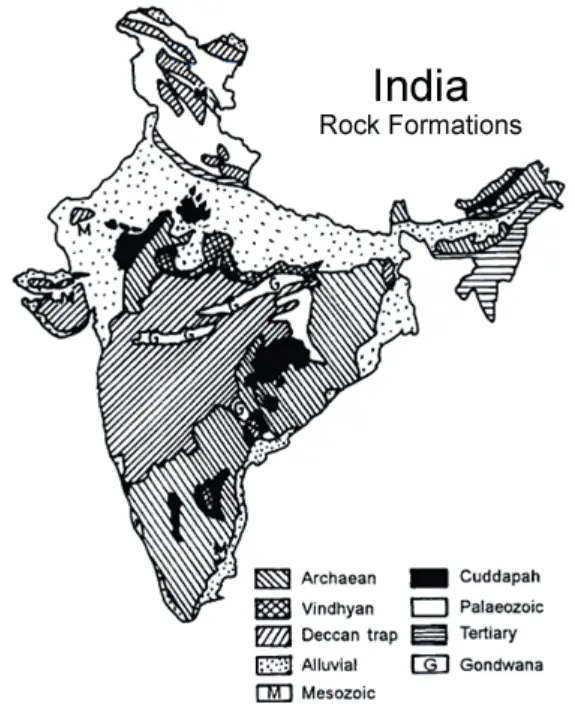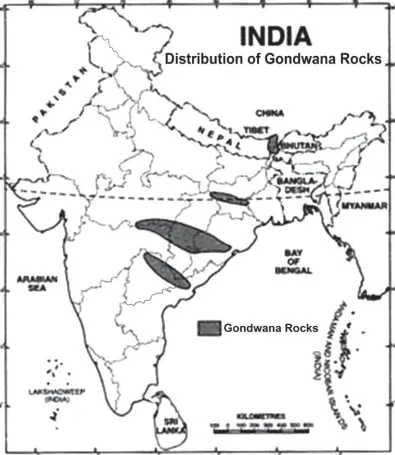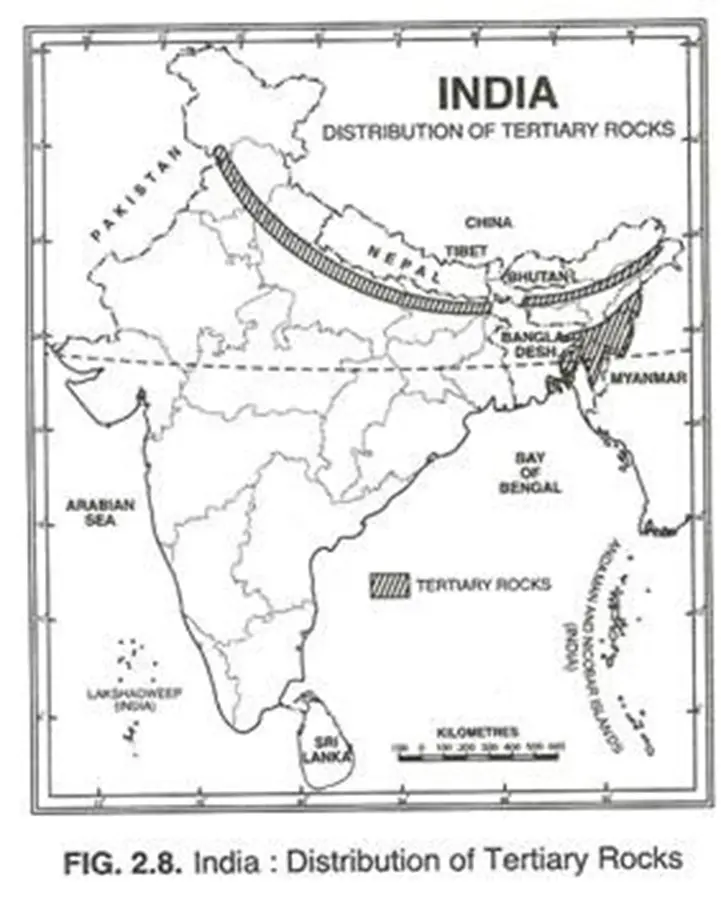India’s Geological Systems: A Brief Overview Indian Rock System
The Vindhyan System, 1300-600 million years old, has diamond-bearing rocks. The Dravidian Rock System, 600-300 million years old, is coal-rich with marine fossils. Carboniferous rocks at 350 million years are known for coal. The Aryan Rock System spans the Upper Carboniferous to Holocene. The Gondwana Rock System, 250 million years old, holds India’s coal and minerals. The volcanic activities in India contribute to the geological landscape, marking a dynamic aspect of Indian rock systems.
Indian Rock System of the Vindhyan Geology and Minerals:
- Origin from Vindhyan Mountains: The name of this system is drawn from the expansive Vindhya mountain range.
- Composition: This geological system consists of ancient sedimentary rocks with a thickness of approximately 4,000 meters, which overlay the Archaean foundation.
- Fossil Absence and Deccan Trap Cover: These rocks are predominantly unfossiliferous, with a substantial portion of this region concealed beneath the Deccan trap.
- Diamond-Bearing Regions: Notably, the Vindhyan system encompasses diamond-rich areas, giving rise to the renowned Panna and Golconda diamonds.
- Mineral Composition:
-
- While lacking in metalliferous minerals, the Vindhyan system yields an abundance of durable stones, ornamental rocks, limestone, and pure sand suitable for glass manufacturing, among other valuable resources.
The Dravidian Indian Rock System: Paleozoic Geology and Coal Formation
- Paleozoic Era: In India, the Paleozoic rock formation is referred to as the Dravidian system.
- This period dates back to the Paleozoic era, specifically 600-300 million years ago.
- It is also known as the Carboniferous rock system, primarily due to its significant coal deposits on a global scale.
- Geographical Distribution: These rocks are predominantly found in regions beyond the Indian Peninsula, including the Himalayas and the Gangetic plain, with minimal presence in the Peninsular shield (Umaria in Rewa).
- Major Regions:
- Prominent regions with Dravidian rocks include PirPanjal, Handwara, Lider valley, Annatnag in Kashmir, Spiti, Kangra, Shimla in Himachal Pradesh, and Garhwal & Kumaon in Uttarakhand.
- Rock Composition: The Dravidian rocks primarily consist of shales, sandstones, clays, quartzites, slates, salts, talc, dolomite, and marble, among others.
- Geological Significance: This era witnessed the breakup of Pangaea and the emergence of the Tethys Sea.
- It marked the onset of life on the Earth’s surface, with abundant fossil evidence in the rocks of this period.
- The presence of marine fossils suggests the prevalence of marine conditions in these Paleozoic rocks in the Indian Rock System.
- Coal Formation:
- The Dravidian period marks the early stages of coal formation, particularly high-quality Carboniferous coal.
- However, such coal formations are not abundant in the Indian Rock System.

Carboniferous Era in the Indian Rock System: Formation of Limestone, Shale, and Coal (350 Million Years)
- Rock Composition and Age in the Indian Rock System: The Carboniferous rocks, which are approximately 350 million years old, are primarily composed of limestone, shale, and quartzite.
- Mount Everest’s Composition: The upper layers of Mount Everest consist of Carboniferous limestones.
- Initiation of Coal Formation: The Carboniferous rocks era marked the beginning of coal formation.
- Geologic Significance of “Carboniferous in the Indian Rock System”:
-
- In the realm of geology, the term “Carboniferous” is indicative of coal-bearing properties.
- It’s important to note that most of the coal found in India does not belong to the Carboniferous period; instead, high-quality Carboniferous coal is more commonly associated with regions such as the Great Lakes in the USA, the UK, and the Ruhr region.
The Aryan Indian Rock System: From Carboniferous to Holocene
- Onset of the Upper Carboniferous Period:
-
- The initiation of the Upper Carboniferous rocks period is marked by the Aryan Group, heralding the beginning of the Earth’s last, longest, and most significant era.
- This era extends from the Upper Carboniferous to the Holocene period, encompassing a remarkable span of geological history.
- Classification of Aryan Group Rock Formation in the Indian Rock System:
-
- The Aryan Group of Rock Formation is categorized within the following groups:
- Upper Paleozoic Era, which includes the Upper Primary Epoch comprising the Upper Carboniferous and Permian Period formations.
- Mesozoic Era, which falls under the Secondary Epoch and includes formations from the Triassic, Jurassic, and Cretaceous periods, such as the Gondwana Rock system, Deccan trap, and Jurassic system.
- Cenozoic Era, encompassing the Tertiary Epoch, which involves formations from the Paleocene, Eocene, Oligocene, Miocene, and Pliocene periods.
- Neozoic Era, under the Quaternary Epoch, which includes the Pleistocene and the more recent Holocene period.
- The Aryan Group of Rock Formation is categorized within the following groups:
Gondwana System in the Indian Rock system: Ancient Deposits and Flourishing Life
- Origin from the Gonds: The Gondwana rock System is named after the Gonds, who are the indigenous people of Telangana and Andhra Pradesh and considered among the most ancient communities.
- Deposition in Synclinal Troughs: These deposits were laid down within synclinal troughs situated on an ancient plateau surface.
- Subsidence due to Accumulating Sediments in the Indian Rock System: The accumulation of sediments led to the subsidence of these troughs.
- Flourishing of Terrestrial Life: Within these troughs, both fresh water and sediments gathered, creating an environment conducive to the flourishing of terrestrial plants and animals.
- Duration Since the Permian Period: This geological phenomenon has been ongoing since the Permian period, dating back approximately 250 million years.

Gondwana Coal in the Indian Rock System: Unveiling India’s Richest in Energy and Mineral Resources
- Dominance of Gondwana Rocks: Gondwana rock system holds nearly 98% of India’s coal reserves.
- Relative Age and Carbon Content: Gondwana coal is comparatively younger than Carboniferous coal, resulting in lower carbon content.
- Rich Mineral Deposits: These formations also contain abundant deposits of iron ore, copper, uranium, and antimony.
- Building Materials: Gondwana rock system offers sandstones, slates, and conglomerates used for construction materials.
The Geological Legacy of India’s Deccan Traps
- Origin of Deccan Traps: The Deccan Traps formed due to volcanic outbursts across a vast region of Peninsular India, commencing at the end of the Cretaceous period and continuing into the beginning of the Eocene.
- Basaltic Lava Flows: Basaltic lava flowed from fissures, covering an extensive area of approximately ten lakh square kilometers.
- Geological Features: These volcanic deposits are characterized by flat tops and steep sides, hence the name “trap,” which means a ‘stair’ or ‘step’ in Swedish.
- Weathering and Erosion: Over millions of years, the process of weathering and erosion has significantly reduced the original size of the Deccan Trap.
- Present Coverage: Currently, the Deccan Trap spans around 5 lakh square kilometers, primarily in regions such as Kuchchh, Saurashtra, Maharashtra, the Malwa plateau, and northern Karnataka.
- Varying Thickness: The thickness of the Deccan Traps ranges from 3,000 meters in the west, decreasing to 600-800 meters in the south, 800 meters in Kuchchh, and only 150 meters at the eastern extremity.
- Formation of Black Cotton Soil: The long-term weathering of these rocks has given rise to the formation of black cotton soil, commonly known as ‘regur.’
The Birth of the Himalayas: India’s Tertiary Period
- The Tertiary period, spanning from the Eocene to Pliocene, occurred approximately 60 to 7 million years ago.
- Notably characterized by two significant events: the final separation of the ancient Gondwana landmass and the upliftment of the Tethys geosynclines, leading to the formation of the Himalayas.
- Geological Significance:
-
- The Tertiary period holds paramount importance in India’s geological history because it marked the birth of the Himalayan mountain range and the establishment of India’s current geographical form.
- Tertiary Succession Distribution:
-
- The Tertiary Succession is widely distributed, encompassing areas like the Bengal and Ganges delta, the East coast, and the Andaman Islands.
- These formations can also be found in regions such as the Salt Range, Potwar Plateau, the outer Himalayan regions of Jammu, Punjab, Assam, Sind, and Baluchistan.
- Notable Indian rock systems within this period include the Karewas of Kashmir, Bhangra, and Khadar of the Gangetic plains, among others.

| Additional Information: |
Significance of GSSPs in Defining Geological Time Periods:
Understanding the International Union of Geological Sciences (IUGS)
The Anthropocene Epoch: Human Impact on Earth’s Geology
|
| Mains( PYQ)
Q. Describe the characteristics and types of primary rocks. (2022) |































